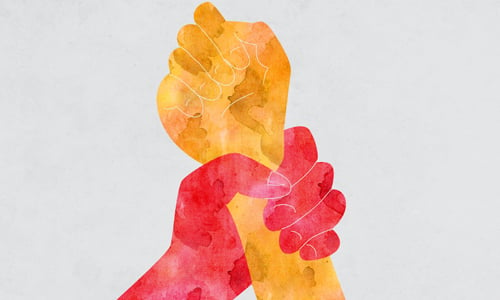In almost all modern societies there are laws prohibiting acts of physical violence. It comes as no surprise that the Torah also considers it a grave sin.
And yet, surely we don’t need G‑d to tell us that physical violence is not allowed, as all half-decent people could come to thisSurely we don’t need G‑d to tell us that physical violence is not allowed conclusion on their own. And that’s not the only obvious commandment. Did G‑d really need to tell us not to murder?
One of the reasons we need these Divine commands is because, although the general prohibition may be dictated by logic, the details are often not,1 For example, it might be obvious that we should not take another person’s life, but when does life start? When does it end? Are there any exceptions?
Additionally, a person is not always capable of remaining objective. Hence these mitzvahs need the force of a Divine commandment to stop a person from bending them because of subjectivity and bias.2
Now let us explore what the Torah actually says about physical violence.
The Prohibition
One who wounds or even hits another person actually transgresses one of the 365 prohibitions of the Torah. Although there’s no verse in the Torah that explicitly forbids hitting, the Talmud derives the prohibition from the verses that discuss the punishment of lashes.3
The verses state that in some instances people who transgress Torah prohibitions receive 40 lashes (which the rabbis explain to mean 39), and that the person giving the lashes “shall not exceed, lest he give him a much more severe flogging than these [40 lashes].”4 In practice, the Jewish courts would assess if the offender was strong enough to withstand the 39 lashes, and if not, he was given only as many lashes as he could bear.5 If the courts would strike the offender even one extra time, they would have transgressed the prohibition of “he shall not exceed.”
Our sages reason: If it is forbidden to give even one extra extra lash to a wicked person, all the more so must it be forbidden to hit an innocent person, who is deserving of no lashes whatsoever.6
The Punishment
Generally speaking, when somebody damages another person’s property he is liable to pay damages. Similarly when one inflicts damage on another person, he is obligated to pay. In addition to actual damages, the Torah obligates the person to pay for pain, doctors’ fees, lost revenue and even embarrassment.
(How these payments are assessed is a subject of an entire chapter in Talmud7 and is beyond the scope of our discussion.)
Now, there is a rule that one who is liable to pay for a transgression is not subjected to corporal punishment as well. However, in a case where no damage was caused, or where the damage was insignificant (less than a small coin’s worth, shaveh prutah), and as a result there was no monetary payment imposed on the offender, then the punishment of lashes was administered.8
In post-Talmudic times, the rabbis instituted a law that, in certain situations, one who commits an act of violence against another person is to be excommunicated and cannot be counted towards a minyan.9
But He Hit Me First
Even in situations where somebody else started the fight, it is nonetheless forbidden to hit back.10 However, if there is no other way of restraining an attacker, it would be permitted to use force, provided that you hit the person no more than is absolutely necessary.11
If You Have Permission
There is a dispute as to whether or not one is permitted to hit someone who has given permission to be hit. The Rivash (Rabbi Yitzchak Ben Sheshet, 1326–1408) rules that it is forbidden,12 and this seems to be the opinion of most subsequent authorities on Jewish law. One reason for this is that one does not have autonomy over one’s body, which is the property of G‑d, and therefore one has no right to allow someone else to hit him.
Exceptions
One is permitted to evict a person from one’s home if that person has no right to be there.13 If he refuses to leave, some authorities permit one to use physical force when evicting him.14 However, the use of force is only permitted as a last resort.
Similarly, when absolutely necessary, it is permitted to use physical force in order to retrieve a stolen object, or for that matter to stop a person from stealing from you.15
Technically, one is permitted to hit one’s children or students in an effort to discipline them.16 However, contemporary halachic authorities say that this does not apply in this day and age.17
Types of Hitting
It must be noted that not all types of hitting are included in the prohibition. Maimonides writes that it is only hitting with malice that is forbidden. (According to another version of Maimonides, only hitting of a “degrading nature” is forbidden.)18
Based on this, Rabbi Moshe Feinstein allows cosmetic surgery, since any wounds inflicted in the process of the surgery are not of a degrading nature, and are not inflicted maliciously.19 However, others disagree with this,20 so be sure to consult a rabbi before any elective surgery. (Read more at Is Elective Surgery Permissible?)
In a similar vein, the second Ashkenazi Chief Rabbi of Israel, Rabbi Isser Unterman, permitted boxing and other forms of combat sports, arguing that they do not fall under the category of hitting with malice.21
Lifting a Hand
When Moses, who was brought up in Pharaoh’s home, left the palace to see how his fellow Jews were doing, he encountered two Jews fighting. The verse states that “Moses turned to the wicked one and asked him, ‘Why are you going to strike your friend?’”22 A close reading reveals that the person had not yet hit his fellow and, nonetheless, the Torah refers to him as wicked. The Talmud concludes that even one who merely lifts up his hand in violence is deemed wicked.23
Some authorities suggest that a would-be striker has not actually committed any sin in the legal sense; the Talmud just wants to emphasize its hard-line approach to interpersonal violence.24
However, most authorities opine that it is a sin to lift a hand in violence.25 There is discussion as to whether this sin is biblical or rabbinical in nature.26 The fact that it is derived from the verse in Exodus would seem to imply that it is forbidden on a biblical level, and this is in fact the opinion of many authorities.27 However, it seems that in Maimonides’ opinion it is forbidden only on a rabbinical level, since this verse does not explicitly teach this law.28
Some authorities rule that one who lifts his hand in violence is not invalidated as a witness.29 The reason for this would be that, although there is a rule that a wicked person is invalidated as a witness, one is considered wicked only if the sin committed is punishable by lashes,30 and the general consensus is that lifting a hand does not warrant lashes.
However, in the opinion of most authorities, and this is in fact the final halachah,31 one who lifts a hand in violence is invalidated from being a witness.Why?
1) Rabbi Yosef Karo posits that, although the rule is that only one who commits a Torah transgression that is punishable by lashes is invalidated from serving as a witness, from the perspective of rabbinic law, an offender can be invalidated even where there are no lashes if the prohibition transgressed is biblical.32
2) Lifting up one’s hand against another person is an exception, since the Torah explicitly called such a person a wicked person and, as mentioned above, wicked people are invalidated from serving as witnesses.33
A number of explanations have been given as to why lifting a hand is forbidden:
1) Lifting up one’s hand is the beginning of the forbidden act of hitting.34
2) The problem lies in the fact that the person has shown intent to commit the sin of hitting another person.35
3) The prohibition serves as a safeguard against the sin of hitting another person. The Torah (or the rabbis) forbade lifting one’s hand against another person so as to prevent people from transgressing the prohibition of hitting another person.36
4) The mere act of lifting one’s hand is an act of violence and shows a negative character trait in the aggressor.37
5) Alternatively, the mere act of lifting one’s hand instills fear in the other person. As a result the aggressor transgresses the prohibition of onaat devarim (verbal oppression), causing emotional pain to another person.38
Practical Ramifications
The Rebbe posits that the distinct reasons given above as to why lifting a hand is forbidden lead to different understandings of the Talmudic statement regarding the offender’s wickedness and eligibility to serve as a witness.39
If one adopts the explanation that raising one’s hand in violence is problematic because it is the beginning of the act of hitting or because it shows intent to hit one’s fellow (explanations #1 and #2 ), then it would be difficult to understand how raising one’s hand could have any legal ramifications. There is a general rule that the Torah does not punish for intent alone, and seeing that no harm has been inflicted on the other person, why would such a person be considered wicked in any legal sense of the world? It therefore makes sense to say that the Talmud was not making any legal statement, but rather is to be understood homiletically. It follows that the act of lifting one’s hand up in violence does not actually invalidate the offender from serving as a witness.
If however, one adopts the explanation that the act of lifting one’s hand up in violence is in itself a negative act (reasons #4 and #5), then there is no reason not to take the Talmud literally to mean that it is a forbidden act, and one can readily understand why it disqualifies one who commits this act from serving as a witness.
The Purpose of Hands
The Rebbe offers a fascinating insight into why lifting one’s hand against another person is considered such a terrible act.
In a talk on Shabbat Parshat Noach 5748, the Rebbe asked why the Talmud specifically states that one who lifts his hand is consideredHands were created to do acts of kindness wicked. Surely one who lifts up any other body part against another person should be considered wicked as well?
The Rebbe answered that there is an important lesson to be learned from the phrasing of this Talmudic dictum. A person’s hand was created to do acts of tzedakah (charity) and kindness. When a person uses his hand for opposite aims, he sins, not only against his fellow man, but also against his Creator, who created his hand for a specific purpose.
This passage of Talmud teaches us how important it is to use all the gifts G‑d has bestowed on us—wealth, health and talents—for the purpose for which they were created, namely, for the service of G‑d.







Join the Discussion